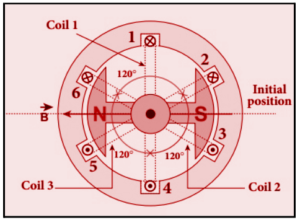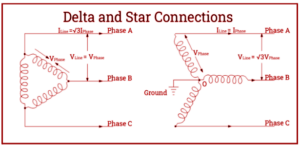Table of Contents
Introduction:
An electrical generator is a mechanism that converts mechanical energy into electrical energy. The generator is usually divided into two types based on the power source, AC and DC. The DC generator’s supply to the machine is single-directional, whereas the AC generator’s supply is bidirectional.
The internal operation of the generators may vary due to the difference in input supply. In AC, slip rings are utilized to generate alternating current in the machine. In both types of generators, the generated voltage or current is initially alternating. An AC generator also referred to as an Alternating Current Generator, is a device that transforms into alternating energy for usage in various appliances on a daily basis.
Slip rings are used in AC generators to produce alternating currents, whereas DC generators produce direct current as a result of their operation.
The information about AC generators and transformers from various physics-related articles are available here. AC generators and their general concepts are important topics in physics. Students who want to flourish in physics need to be well known about AC generators and transformers to get deep knowledge about it to do well on their exams. The definition, working principle, and diagrams are provided here to assist students in effectively understanding the respective topic. Continue to visit our website for additional physics help.
Overview:
In general, the AC Generator is a device that transforms mechanical energy into electrical energy in the form of alternating current or voltage. Faraday’s law of electromagnetic induction governs the operation of the machine. The DC voltage is made to revolve inside the stationary coil, much like a massive power generator that generates AC current.
The AC generator is used to produce AC current in bicycles, electric scooters, microwaves, and sailboats. Gas and steam turbines, as well as internal combustion engines, provide mechanical energy to the AC generators.
These are also very effective in converting high-pressure gas streams to lower-pressure zones in wind turbines and small hydropower plants.
The direction of the alternating current in the generator is determined using Fleming’s right-hand rule.

An AC generator has two poles, which are the north and south poles of a magnet, to produce a consistent magnetic field. The armature is a rectangular coil that is attached to the coil. Carbon brushes are hooked to these coils, which are connected to the slip rings.
The metal slip rings are employed that are separated from one another. Each brush has one end that attaches to the ring and the other end that connects to the circuit. The rectangular coils spin around a perpendicular axis to the magnetic field. There’s also a shaft that spins quickly.
Working Principle of an AC Generator:
The functioning principle of the AC generator is based on Faraday’s law of electromagnetic induction. When a conductor breaks the lines of magnetic flux, causing current to flow through the conductors, an EMF is created.
When the armature rotates between the poles of the magnet on an axis perpendicular to the magnetic field, the flux that links with it varies continuously. As an outcome, an emf is generated in the armature. An electric current is generated by the galvanometer, as well as the slip rings and brushes. The galvanometer alternates between readings that are positive and those that are negative. The galvanometer is obtaining an alternating current, according to this.
Emf induced in an AC generator:
The motional emf produced by rotating a coil of N turns and area A at v rotations per second in a uniform magnetic field B is e=NBA(2v)sin (2v)t, here we are assuming that at time t=0 s, and the coil is perpendicular to the field.
Fleming’s right-hand rule, often known as Lenz’s law, determines the direction of the induced emf. According to Fleming’s right-hand rule, stretch the forefinger, middle finger, and thumb of the right hand so that they are manually perpendicular to each other.
The direction of the magnetic field is shown by the forefinger, whereas the direction of conductor motion is indicated by the rhumb. The direction of the induced current in the conductor is represented by the middle finger.
3-Phase AC generator:
Three conductors carry an alternating current of the same frequency and voltage amplitude relative to a common reference in a symmetric three-phase power supply system but with a phase difference of one-third the period. The common reference is commonly connected to ground and, in certain cases, to a neutral current-carrying conductor.
The voltage on any conductor rises one-third of a cycle after one of the remaining conductors and one-third of a cycle well before another conductor due to the phase difference. Because of the phase delay, a balanced linear load receives continuous power transfer. The galvanometer is receiving an alternating current, according to this.
It also enables the creation of a spinning magnetic field in an electric motor and the generation of other phase arrangements through the use of transformers.

Transformers:
The voltage is converted to higher or lower voltages by the gadget. When electrical power is generated and transferred, several voltage levels are used. A transformer is made up of two coils: primary/field and secondary/inductance, which are kept apart from such that no electrical contact occurs between them.
When we let current flow through the primary coil, a magnetic field is generated that changes. It does, however, keep the same frequency. As a result, an alternating voltage is generated in the secondary coil at the same moment. During the closed electrical circuit, an alternating current goes via a secondary coil.
Three-phase Transformer:
Three-phase transformers are those that use a three-phase electrical system to operate. A simple single-phase transformer is the sort of transformer discussed in the preceding chapter. Faraday’s Law of Induction governs the operation of three-phase transformers. The wire configurations of single-phase and three-phase transformers differ. It is better to look into three-phase electrical systems to gain a better understanding.
Three windings for the primary and three for the secondary make up a three-phase transformer. The main and secondary windings on each side can be coupled in either a delta or a star arrangement.
These windings can be seen as single-phase windings on their own. Three single-phase transformers can theoretically be combined to make a three-phase transformer.

Also read: Important Topic of Physics: Ammeter
Frequently Asked Questions (FAQs):
Question 1: What is an AC Generator?
Answer: A device that transforms mechanical energy into electrical energy is known as an AC generator. Steam turbines, gas turbines, and combustion engines provide mechanical energy to the AC Generator. Alternating electrical power in the form of alternating voltage and current is the product.
Question 2: What is a 3-phase AC generator?
Answer: In an asymmetric three-phase power supply system, there are three conductors that carry alternating current at the very same frequency and voltage amplitude, but with a phase difference of one-third the period relative to the common reference. The most common reference is the one that links to the ground, which is usually a current-carrying wire with no net current.
The voltage on any conductor tends to reach its peak one-third of a cycle after one of the other conductors and one-third of a cycle before the remaining conductor due to the phase difference that emerges.
This phase delay ensures that electricity is transferred to a balanced linear load at a constant rate. It also makes it feasible to generate a rotating magnetic field, similar to that seen in an electric motor, and so generate a different phase arrangement while employing transformers.
Question 3: What is the Principle of the AC Generator?
Answer: The AC generator operates using Faraday’s law of electromagnetic induction.
A shift in the magnetic flux occurs when the coil rotates. The electrons are moved by the EMF induced in the coil, which causes the generation of an electric current, according to Faraday’s law of electromagnetic induction.
The circuit is closed through the load (light), and the current created is alternating in nature, just as the flux.
Question 4: How does an AC generator produce electricity?
Answer: The functioning of AC generators is governed by Faraday’s law of electromagnetic induction. The flux linkage keeps changing when the armature rotates between the magnet’s poles on an axis perpendicular to the magnetic field. As an outcome, an emf is generated in the armature. As a response, the electric current passes via the galvanometer, slip rings, and brushes.





